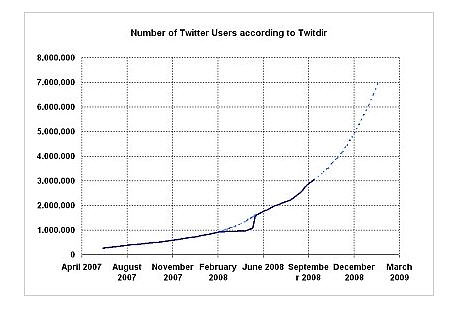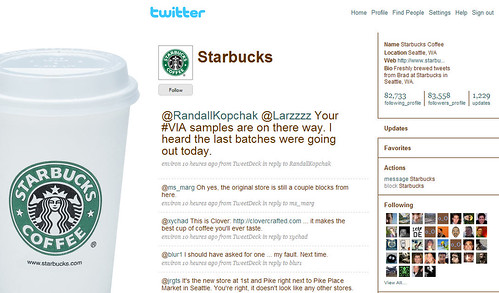Voici près d’une quinzaine de liens glanés ici et là cette semaine. Vous remarquerez que plusieurs portent sur Twitter. Ce n’est pas un hasard… Twitter vit une crise de croissance exponentielle avec une augmentation de 756% en 2008, ce qui laisse songeur quant aux capacités de ses dirigeants de gérer cette irrésistible montée en puissance.

Rumeurs d’offres d’achat, compétition des grands comme Facebook avec sa nouvelle page d’accueil, spamming et entrée en masse des firmes et entreprises, dont le succès phénoménal de Starbucks, reportages dans les grands médias traditionnels.

Nous le remarquons tous et toutes qui sommes sur Twitter depuis les modestes débuts. Notre nombre de «followers» a grimpé de façon exponentielle, surtout depuis la création des #FollowFriday. Bref, lisez au moins les huit premiers et surtout le second, qui viennent comme en écho à un de mes récents billets sur le sujet .
Whoa, Twitter Mania
Can Twitter Survive What is About to Happen to It?
For Twitter C.E.O., Well-Orchestrated Accidents
Lance Armstrong: Natural Born Twitterer
At SXSW, attendees confront Twitter saturation
Twitter Drives Traffic, Sales: A Case Study
Why Twitter Turned Down Facebook
How I Built a Twitter Network of 10,000 in My First 100 Days
Quelques autres liens intéressants :
La résistance du livre
Newspapers and Thinking the Unthinkable
Welcome to the PepsiCo Social Experiment and SXSW
Scoble’s New Thing: Building 43
Web 2.0 tools can foster growth in hard times
Un évènement a changé le monde il y a 20 ans : La naissance du WWW !

2 Commentaires
tu peux expliquer le cas starbucks ?
Repris sur cnet.com :
«@Starbucks’ Twitter strategy is worth looking at. Starbucks doesn’t inundate Twitter followers with advertisements. Instead, its Twitter account gives consumers the opportunity to access the company in a way they never have.
When a user corresponds with a corporate account on Twitter, they may not really expect it, but will be happy to see that there’s a person on the other end. I have sent messages to the Starbucks’ profile, which, as it happens, is run by an employee of the company. The responses have thoughtful, forthright, and most importantly, human — it doesn’t stink of marketing rhetoric.
From a consumer’s perspective, that’s ideal. How often can we really get in touch with corporate people in the position to make a difference? In my experience, telephoning customer service usually yields nothing more than banalities and scripted responses. But a Twitter profile can allow me to talk to a person at the company, creating a scenario where I develop a dialogue between myself and the organization. And it changes my perception, and makes me feel heard. Starbucks does this very well.»